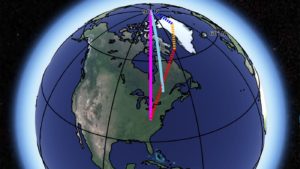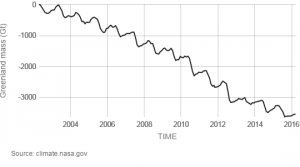 The Nature article Nonlinear rise in Greenland runoff in response to post-industrial Arctic warming by Luke Trusel et. el. (12/5/18) reports on Greenland ice sheet runoff. Referring to fig 4a (copied here) in their paper
The Nature article Nonlinear rise in Greenland runoff in response to post-industrial Arctic warming by Luke Trusel et. el. (12/5/18) reports on Greenland ice sheet runoff. Referring to fig 4a (copied here) in their paper
We show that an exceptional rise in runoff has occurred over the last two decades, equating to an approximately 50% increase in GrIS-integrated runoff compared to pre-industrial runoff, and a 33% increase over the twentieth century alone.
The Woods Hole Oceanographic Institution (WHOI) provides a less technical summary of the paper in their post Greenland Ice Sheet Melt ‘Off the Charts’ Compared With Past Four Centuries (12/5/18).
Ice loss from Greenland is one of the key drivers of global sea level rise. Icebergs calving into the ocean from the edge of glaciers represent one component of water re-entering the ocean and raising sea levels. But more than half of the ice-sheet water entering the ocean comes from runoff from melted snow and glacial ice atop the ice sheet. The study suggests that if Greenland ice sheet melting continues at “unprecedented rates”—which the researchers attribute to warmer summers—it could accelerate the already fast pace of sea level rise.
“Rather than increasing steadily as climate warms, Greenland will melt increasingly more and more for every degree of warming. The melting and sea level rise we’ve observed already will be dwarfed by what may be expected in the future as climate continues to warm,” said Trusel.
The WHOI post includes a short video with a graph similar to the one copied here and a summary of the science. The Nature article has data available.
As an aside, while we are talking about Greenland, in NASA news International team – NASA make unexpected discovery under Greenland ice (11/15/18)
An international team of researchers, including a NASA glaciologist, has discovered a large meteorite impact crater hiding beneath more than a half-mile of ice in northwest Greenland. The crater — the first of any size found under the Greenland ice sheet — is one of the 25 largest impact craters on Earth, measuring roughly 1,000 feet deep and more than 19 miles in diameter, an area slightly larger than that inside Washington’s Capital Beltway.
The NASA article includes a short video.



